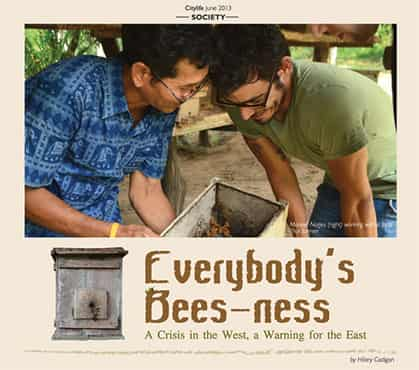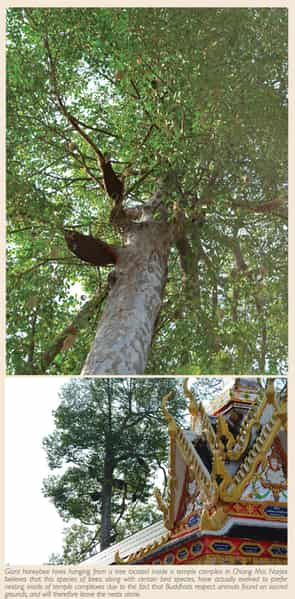
“Once the bees have left the earth, man will have four years left on the planet.”
According to an April 2013 article in Al Jazeera, this chilling statement was made by none other than Albert Einstein, near the end of his Nobel Prize winning life.
While some have questioned the source of this now famous quotation, the message itself is bona fide: the disappearence of bees spells catastrophe for mankind. Most chilling of all? It’s happening as we speak.
“The world’s bee population is in steep decline,” the article states. “It matters because bees pollinate the plants that produce a third of all the food mankind eats.”
Collapse of the Colony
To learn more, I spoke with resident bee expert Manuel Narjes, born in Colombia, schooled in Germany, and currently living in Chiang Mai on a research grant, studying the economics of bee pollination for a Ph.D in Agricultural and Environmental Economics from Hohenheim University in Stuttgart.
Young and energetic, with movie star good looks and rockstar tattoos, Narjes does not exactly fit the portrait of dour academic. Perhaps that’s why his presence here is so refreshing. He hasn’t come to Thailand just to preach at us or bury our heads in scientific facts. Rather, he is here as an explorer himself, well-versed in the subject of honeybees but seeking more knowledge about their fascinating relationship with humans, and why the bond between us and the bees is such an important one. But first, being a bit of a bee-ginner myself (heh heh), I asked Narjes to give me a brief rundown of the current situation. Unfortunately, the picture he painted was not a pretty one.
“North America has been faced with an abrupt and dramatic decline of bees since around 2006,” Narjes told me. “It’s called Colony Collapse Disorder, and it basically means that bees are just disappearing for no apparent reason.”
Researchers have identified three credible contributors to Colony Collapse Disorder (CCD). The first is North America’s increasing reliance on monocultures, where a single type of crop is grown over a wide area for many years. Monocultures produce large yields (read: big bucks) but are also harmful in the long term because they provide such a monotonous diet for bees, which can lead to malnourishment and weakened immune systems.
Another issue is the widespread usage of pesticides called neonicotinoids, which are chemically similar to the addictive substance found in tobacco. (In fact, tobacco was the first pesticide ever used by humans, according to Narjes.) Today, seeds are coated with these neonicotinoids before planting, so that every part of the growing plant is tainted by the pesticide, including the nectar and the pollen that the bees consume in order to pollinate other plants. Neonicotinoids attack the bee’s central nervous systems, causing them to become highly disoriented and unable to find their way back to their hives, so that they eventually die.
“One should never see a single bee as a complete organism,” explains Narjes. “A bee colony is known as a ‘superorganism’… so, if many start dying or failing to return to the hive, it is ultimately the whole that is at risk of perishing.”

The Bigger Picture
A recent report from the European Union’s European Environment Agency notes that pesticides also make honeybees more susceptible to natural dangers, namely a tiny death machine called the Varroa mite, which latches on to the unsuspecting honeybees, sucking their lymph and transmitting diseases that can paralyse, deform and even kill them.
While there are a variety of different theories about the specifics, deadly mites are actually believed to have entered the West thanks to human intervention in Asia. One rather damning hypothesis places the onus on a group of unwitting American Peace Corps workers, who introduced the European honeybee to the Phillipines way back at the turn of the last century – an attempt to do good that went quite wrong.
As Narjes explains, native Asian honeybees have co-evolved with the mites, making them less susceptible to infestation. The European honeybees, on the other hand, were completely evolutionarily unprepared for such an invader, so that their sudden exposure spread quickly and proved deadly, working in tandem with the other factors to eventually wipe out the already weakened bees.
While the honeybee situation in Asia is not yet as dire as it is in the west, thanks to stronger bees and more virgin forests, Narjes notes that it’s crucial to view the western crisis as a warning for Asia’s future.
“Here in Southeast Asia, native honeybees could soon have the same problems because agriculture is done in a very unsustainable way,” he says. “Deforestation and pesticides are huge, huge problems in Thailand, and have already caused localised native bee declines and subsequent declines in crops that are dependent on the intervention of bees for their reproduction.” In other words, if Thai farmers keep on burning and using pesticides, Asia’s bees could go down the same tragic path as America’s.
Sweet Sorrow
Another problem in Thailand that has led to problems is the practice of honey hunting. Say you’re at the Sunday Walking Street, striding along with your brand new Lanna something or other and your string lights, and you happen across a stand selling honey. “How nice!” you may think to yourself. “Local honey, fresh from the forest!”
Stop right there. Put that honey down.
“If you see people in the markets of Chiang Mai selling ‘forest honey’, know that this often comes from [a process called] honey-hunting,” notes Narjes. “The honey is usually gathered by killing wild bees, by burning leaves and smoking out the colony. Sometimes they will escape, but sometimes the queen bee won’t be lucky enough, and a colony without a queen is doomed.”
Okay, so honey hunting is unsustainable and should not be supported. Got it. But listen up, because this is not the only way to acquire honey. So don’t give up on your favourite sticky sweetener just yet. In fact, honey contains a whole host of health benefits – it is packed with antioxidents, reduces cough and sore throat, regulates blood sugar, acts as an antibacterial both internally and externally, and has even been said to improve athletic performance.
And when we look at the bigger picture, from both an economic and ecological standpoint, responsible beekeeping can be quite useful and sustainable for humans and bees alike – in ways that go far beyond a spoonful of honey on a scraped knee.
The Birds and the Bees
“So, do you think it would be beneficial if all farmers were also beekeepers?” I asked Narjes.
“Yes, definitely,” he replied, noting that one reason why Thailand has been such an interesting place to study is because farmers here are often highly reliant on bee pollination, which is of very high economic importance in the region.
Not only do bees produce honey, which farmers can sell for additional profits, but they also provide pollination – essentially a free year-round service, courtesy of your friendly local honeybees. In fact, only a small percentage of flowering plants are pollinated without animal assistance. The rest require pollinators, organisms that carry pollen grains between the flowers’ reproductive organs, allowing them to procreate through a process called biotic pollination. Get it, kids? The birds and the bees? In fact, while other kinds of insects, as well as some animals like bats and birds, do act as pollinators, Narjes says that 90 percent of animal-assisted pollination is assigned to bees.
Money for Nothing
Narjes’ work in Chiang Mai has focused on the economics of bee pollination, specifically crop pollination for soapberry trees like lychee and longan. His primary occupation is interviewing local farmers, which involves trying to explain to them the vital role that bees play in the agricultural process of producing fruits and gauging their reactions to potential government regulations and scenarios of the future, including whether they would be willing to pay for certain components of policy.
“My biggest challenge is getting farmers to understand the hypothetical situations,” says Narjes. “Many farmers don’t understand the role of bees or what crop pollination means. Some even think bees are harmful, that they eat their food. I try to change their mindset by giving them a short presentation on what bee pollination is, but this can come at a high cognitive cost. They’re often overwhelmed. Many have never even seen charts before.”
So, the fact that many farmers are unaware of the mutually beneficial relationship between them and the bees is one issue. Another is the power of tradition. Farmers who have been practicing slash and burn agriculture for generations are not likely to change their practices, especially in the face of seeming denial on the part of the authorities.
“Ideally, pesticides and forest burning would be banned or at least regulated, but [creating and enforcing] regulation from the government in Thailand is so hard,” Narjes adds.

Burn Baby Burn
Of course, if you’ve even been in Northern Thailand during the months of March and April, you already know the saddening and maddening old story of government regulations (or lack thereof) around these parts.
The yearly recurrence of crop burning brings extremely harmful effects to pretty much all parties involved. It disrupts biodiversity and destroys natural habitats for bees and many other species, makes farming more difficult in the long run, and brings about a slew of health risks to humans forced to breathe in the polluted air that it creates – an issue illustrated all too clearly every spring.
So why does it still happen? As Narjes explains, forest burning is a very traditional way of farming in Southeast Asia. Also called rotational or swidden agriculture, the process involves burning one piece of land in order to harvest nutrients from the ashes, which are then incorporated into the soil, providing good yields for two to three years afterwards. Ideally, the land would then be left fallow for 20 years to recover before farmers came back to plant there again. It’s supposed to be a sustainable cycle. But now that populations are higher, resources are slimmer and people are reclaiming more and more land from the forests, the cycles have become much tighter, allowing only six fallow years or less. As a result, the land is never given enough time to return to its proper state, leading to a constant ecological decline.
“If you ask farmers what they think of biodiversity, they’ll say ‘yeah it’s cool,’ but the question is how much they’re willing to give up in terms of yields, labour, et cetera in order to achieve that goal,” says Narjes. “They often don’t understand the function of ecosystems and the role of bees and other insects. They don’t see the link, or don’t believe it. I think if they were educated on that level, through agricultural extension services of some kind, they could help create a healthier ecosystem.”
The Final Fish
The problem with poor farmers in any country, Narjes notes, is that they think in very short terms. Why? Because they cannot afford to wait.
Narjes illustrates his point with a little analogy about fish, telling me to imagine there is only one fish left in the river. It’s the very last fish, maybe ever. You shouldn’t eat it, right? Because then fish will be extinct and you’d be faced with a fishless future. But if you’re hungry – starving, as the case may be – what is there to keep you from eating that fish?
“If I don’t eat that last fish today I might not even survive to see a future without it,” Narjes concludes.
This analogy highlights the direness of Thailand’s situation. While we are not yet facing the same kind of generalised pollination crisis here as we’re seeing in North America, there are plenty of other disturbing statistics of note. In fact, Narjes points out that Thailand currently retains only 25 percent of its original forest cover, maybe less. The pollution and release of carbon dioxide into the atmosphere every year during burning season is also highly alarming. It seems obvious that burning is wrong and deforestation is tragic, and yet…
“Poverty deprives you from giving up on something as an investment for the future,” Narjes explains. “Farmers know that slash and burn agriculture and pesticides are bad for the environment and us but they still use them because they want the yields of this year and next year to be high. The cost in terms of health, et cetera in the long run is of little importance. Instant gratification is more valued than future consequences.”
And isn’t this really the problem with humanity in general? It explains the larger problems that surround food production in the west – the reliance on monocultures, the dismissal of the dangers of pesticides and the constant drive toward immediate profits with no heed for future scenarios (however disastrous they might be). But it’s time to face facts, because if we don’t start looking at the bigger picture, there soon won’t be any picture left to look at.
A Light in the Dark
Luckily, some people seem to be catching on. On 29th April of this year, the European Union voted for a two-year ban on three different types of neonicotinoids, preventing them from being used on crops attractive to bees throughout the EU. This was in part thanks to public action, including targeted protests and global online petitions started by nonprofit organisations like Avaaz. Chemical mega-companies like Bayer and Syngenta lobbied hard for their money-making pesticides, but the voice of the public held strong and contributed to an inspiring win.
Our fellows in the west give us two examples to learn from as we look toward Asia’s agricultural future. One is negative and one is positive. The negative shows us what happens when we ignore long-term consequences in favour of short term profits, and unfortunately we’ve yet to see the full extent of the consequences of bee decline. But the other is a positive example: that public outcry can change government policy, and that education and awareness are worth spreading.
So, Thailand, what’s it going to… bee?
